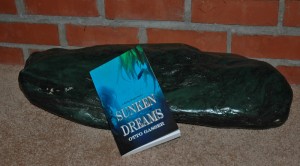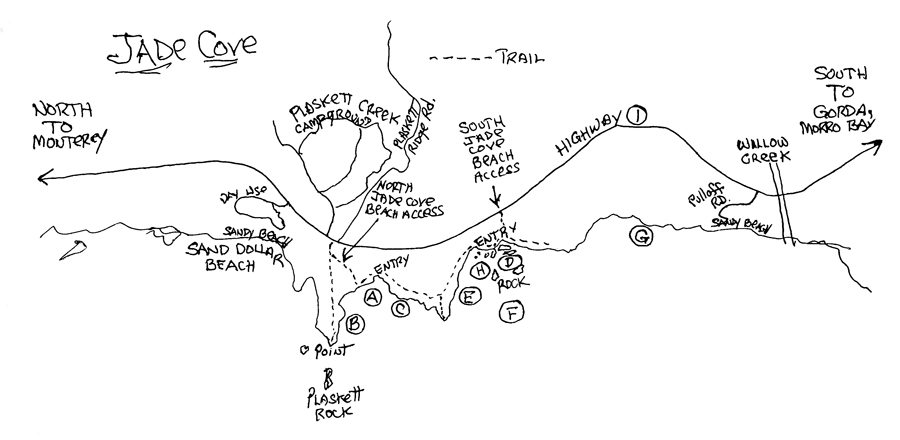 During 1980 through 1990 I spent a lot of time diving Jade Cove. Not only did I travel there to dive with friends, but I also took my advanced Scuba class there as one of its special trips to explore the different topography and animals north of Southern California. We would camp at Plaskett Creek Campground for several days and dive the areas around Jade Cove if the weather was permitting. When the surf came up we went north to Monterey Veteran’s Memorial Park Campground and dove on sites around Monterey.
During 1980 through 1990 I spent a lot of time diving Jade Cove. Not only did I travel there to dive with friends, but I also took my advanced Scuba class there as one of its special trips to explore the different topography and animals north of Southern California. We would camp at Plaskett Creek Campground for several days and dive the areas around Jade Cove if the weather was permitting. When the surf came up we went north to Monterey Veteran’s Memorial Park Campground and dove on sites around Monterey.
At that time you could take jade as long as it was on collected by hand on the beach or under water. So, during those trips we hauled a lot of rock off the beach and out of the ocean, and had a lot of fun doing it. When the weather allows you to dive Jade Cove is an excellent place to get wet. I haven’t been back there for several years, but here is my recollection of the rewarding experiences we shared camping and diving along this stretch of the California coast.
 Facilities: Another camping facility that is semi-close to the cove is Kirk Creek Campground located about six miles to the north. There is no real market to buy food near either of these two campgrounds, so if you decide to camp at one of these locations shop for groceries in advance. Other recommended campgrounds include San Simeon State Beach 25 miles south, and Morro Bay State Park even further south. These two have shower facilities which aren’t available at either the Plaskett Creek or Kirk Creek. They are also located close to dining and grocery shopping areas. Both Morro Bay and nearby Cayucos have motels, and the last time I was there you could get air fills at a dive shop near the foot of the Cayucos pier.
Facilities: Another camping facility that is semi-close to the cove is Kirk Creek Campground located about six miles to the north. There is no real market to buy food near either of these two campgrounds, so if you decide to camp at one of these locations shop for groceries in advance. Other recommended campgrounds include San Simeon State Beach 25 miles south, and Morro Bay State Park even further south. These two have shower facilities which aren’t available at either the Plaskett Creek or Kirk Creek. They are also located close to dining and grocery shopping areas. Both Morro Bay and nearby Cayucos have motels, and the last time I was there you could get air fills at a dive shop near the foot of the Cayucos pier.
General Information: You can dive Jade Cove any time of the year and find jade, but I’ve found that the best hunting is during the winter and spring months. You have to catch the few calm days that slip in between the storm systems that march down the coast and churn things up during that time of the year. When the big swells roll down from the north, kelp is ripped up from the shallower areas of the sea floor and deposited on the beach making a mess there. However, that also creates more new and open areas for you to search for jade, and it increases the odds of finding a nice chunk of mineral. The summer months are warmer, but the kelp growth flourishes then, and jade is harder to find under that shadowy mantel of the kelp canopy.
Jade can be very hard to recognize at first, so beginning divers usually don’t find a lot of jade, but the jade that they do find is usually of better quality. Later, when your eye becomes trained to spot smooth green rocks, you’ll find much more Jade rock, but some of it may be of poorer quality (junk jade). I stopped taking junk jade (impure pieces) after my second or third trip. When they dry out you’ll know that they’re not worth keeping, and that they sure weren’t worth carrying back up the cliff to the car. Don’t be greedy, the good stuff is a joy to display around the house, and you can tell and retell the stories you invent about finding it.
When you dive here I recommend that you take a float with a game bag attached. That way you can ride out to your chosen search area, tie the float off on the kelp, and run a search pattern nearby on the bottom. Then, if you get lucky and snag a larger piece of jade, you can dump it onto your float and that makes your return trip to shore a lot easier.
Warning! These two narrow coves can develop some nasty rip currents when the surf is up, and even strong swimmers can have trouble fighting through these to get back to shore. This is especially true in the north cove. When the surf is large a lot of water will role up onto the beach and then rush back to sea dragging everything that’s loose along with it. You should definitely avoid diving during these times. Diving Jade Cove is fun when the conditions are favorable, but it’s a real bitch when they’re not. Know your own limitations and don’t exceed them, and always dive safe. Even if you can’t dive on a given day you can still have fun. I suggest you stick to combing the beach where you can find small pieces of Jade, or travel north or south, and enjoy being a tourist.
North Jade Cove
The north cove is directly across Hwy 1 from Plaskett Creek Campground. Access is off the road via a raised style over the fence, and then a short hike down to the cove. The trail down the cliff changes every winter when the weather shifts things around, so take the time to check out the trail before finalizing your diving plans. The safest entry area is on the beach south of the trailhead. It’s a small pebble-covered beach that fronts the ocean along the south end of the cove. This is also where most beachcombers look for their jade. One other thing of note! The water will be a lot colder than it is in southern California.
You can hunt for Jade almost anywhere from the shore on out to sea. Look in the gravel patches between rocks in the middle of the cove in the shallower area marked A on your map. Don’t hesitate to use your hands to sift through these patches for the best results. Area B to the north is a large rock strewn area where you can find jade in the gravel between the rocks or in several small caves formed under the larger boulders. This is also the best area for spear fishing for your dinner. Area C is to the south and extends along the cliff there where you can swim through an underwater arch and search further out to sea. At times, I’ve done well hunting along all of these areas.
A short story
One fine sunny March day I was diving in the north cove with a group of students from my advanced class. I was working outside to the south, and was doing okay but not super. Near the end of the dive I was towing my float, and working along the bottom back towards shore, when I noticed the end of a jade rock protruding from the sand. I already knew that there was a large vein of jade that sometimes exposed itself in that area, and if it was the top of that huge structure you could touch and admire the shelf of rock, but you weren’t going to be able to do much else. I thought that the protruding rock was probably part of this ledge, but I finned over to check it out anyway. Much to my surprise it turned out to be an independent mineral rock that later weighted out at 89 pounds. I had this quality piece of jade half uncovered when I started to run out of air, so I called over a student to baby sit my rock while I went back to the car for a new tank of air. When I got back to my new found chunk of treasure I was happy to find out that my student had worked to uncover the whole thing. It was way too big to swim to the surface, and I didn’t have a large lift bag available, so I did the next best thing. I took off my fins, picked up the rock, and walked to shore along the bottom. Believe me, negative buoyancy was no problem at the time. There was another problem though, because I still had to lug that heavy sucker back to the car. That was accomplished with lots of grunting and rest stops along the way, and maybe a beer break or two. I rewarded my helpful student with several nice but smaller jade pieces for helping me, but he still thinks he should inherit my rock when I die. Sorry Reed, it isn’t going to happen. This specimen still graces my living room floor, and it generates a lot of interest with visitors. When someone asks me about it I get to retell my story of the hardships I endured recovering sunken treasure at Jade Cove. If you dive there, maybe you’ll end up with a story to tell, too.
Next week, I’ll talk a little more in detail about South Jade Cove.
